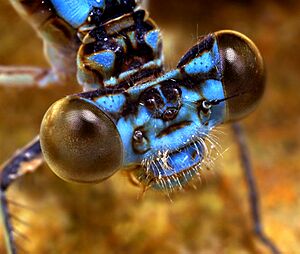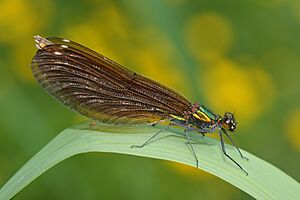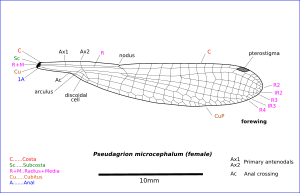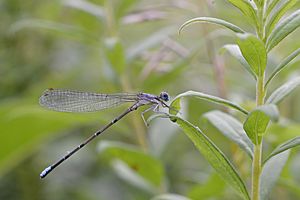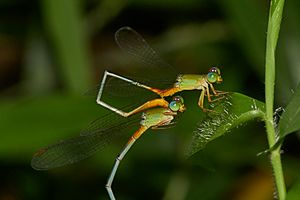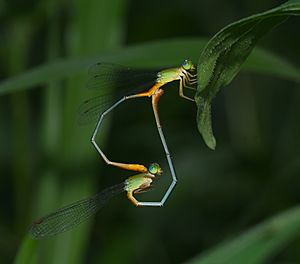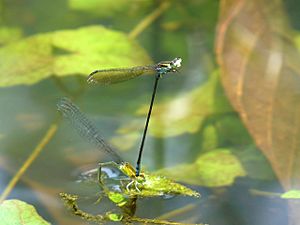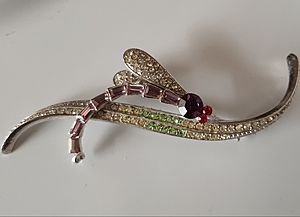Damselfly facts for kids
Quick facts for kids Damselflies |
|
|---|---|
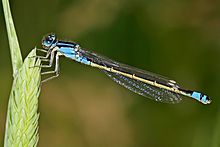 |
|
| Male Common Bluetail damselfly | |
| Scientific classification | |
| Kingdom: | |
| Phylum: | |
| Class: | |
| Order: | |
| Suborder: |
Zygoptera
Selys, 1854
|
Damselflies are amazing insects. They belong to a group called Odonata. Damselflies look a lot like dragonflies. But they are in their own special group, called Zygoptera. There are 20 different families of damselflies.
Contents
What Makes Damselflies Special?
Most damselflies hold their wings close to their body when they are resting. Their wings are held straight back. Some damselfly families, though, hold their wings open. This is like how true dragonflies (Anisoptera) rest.
Damselflies are usually smaller than dragonflies. They also do not fly as strongly. Their eyes are set far apart. They are separated by more than the size of one eye. Another way to tell them apart is their wings. Both the front and back wings of a damselfly look the same. This is not true for dragonflies.
Like dragonflies, damselflies cannot walk. They can only land. Their life cycle is also very similar.
Damselflies have a hard outer shell called an exoskeleton. They often have bright colors. But when they land on a bush, away from the sun, they are hard to spot. They land and close their wings very quickly.
Their eyes are great at seeing movement. If anything moves nearby, they fly away fast. So, even though they look delicate and colorful, predators find them hard to catch.
Damselflies (except for spreadwings, Lestidae) rest with their wings together. They hold them above their bodies. Dragonflies rest with their wings spread wide apart.
Damselflies have thinner bodies than dragonflies. Their eyes do not touch each other.
Where Do Damselflies Live?
Odonates, which include damselflies, live on every continent. The only place they are not found is Antarctica. Some dragonflies live in many places. But damselflies usually live in smaller areas.
Most odonates lay their eggs in fresh water. A few damselflies, from the Caenagrionidae family, lay eggs in salty water. Only one type of dragonfly lays eggs in seawater.
Most damselflies stay close to where they were born. But some types, and even some individual damselflies, travel farther.
What Do Damselflies Eat?
Adult damselflies catch and eat small insects. They eat flies, mosquitoes, and other tiny bugs. They often hover among grass and plants. They pick prey off stems and leaves. They use their spiky legs to grab food.
Damselflies mostly use their eyes to find food. But they might also use their sense of smell.
No damselflies are known to hunt at night. But some hunt at dawn or dusk. This might help them catch newly hatched flies. They can also catch other water insects. This happens when bigger dragonflies are resting. In South America, some large damselflies (Pseudostigmatidae) eat spiders.
Where They Live and Grow

Damselflies live in and around wetlands. These wet areas are needed for their young to grow. They need open spaces to find mates. They also need good places to rest. They need open areas, roosting spots, and plants for laying eggs. Clean water is also very important. Different damselfly types need different water conditions. This includes water depth, how fast the water moves, and its pH level.
Who Eats Damselflies?
Damselflies, both young and adult, are eaten by many animals. These include birds, fish, frogs, and even other dragonflies. Other predators are other damselflies, water spiders, water beetles, backswimmers, and giant water bugs.
How Damselflies Behave
Many damselflies have special ways of showing off. This is called courtship. Males show their unique features. They might show off bright colors or their flying skills. This helps them prove they are strong and healthy.
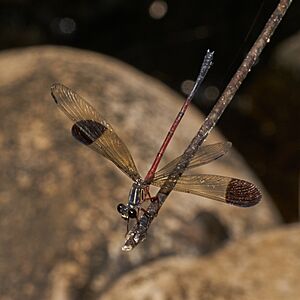
Other things damselflies do include wing-warning and wing-clapping. They also do "flights of attrition" and "abdominal bobbing." Wing-warning is when they quickly open and close their wings. This is an aggressive sign. Wing-clapping is slower. They open their wings slowly, then close them fast. They might do this up to eight times. It often happens after flying. It might help them control their body temperature. Flights of attrition happen when males fly around each other. They keep doing this, sometimes for a long time. One insect eventually gets tired and gives up.
At night, damselflies usually rest in thick plants. They perch with their body along a stem. If something bothers them, they move to the other side of the stem. But they usually do not fly away.
Reproduction
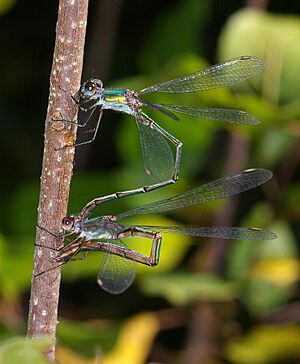
All damselflies lay their eggs inside plants. Those that lay eggs underwater can stay underwater for 30 minutes. They climb along water plants. They lay eggs at different spots.
Many damselflies can have more than one group of babies each year.
The Damselfly Life Cycle
Damselflies are hemimetabolous insects. This means they do not have a pupa stage. The female uses a special tool called an ovipositor. She makes cuts in water plants or other underwater surfaces. Then she lays her eggs inside. The young damselflies are called naiads or nymphs. They almost always live completely in water.
The spreadwings lay eggs above the water late in the year. These eggs stay through winter. They are often covered by snow. In spring, they hatch in the melted snow pools. The nymphs grow quickly before these temporary pools dry up.
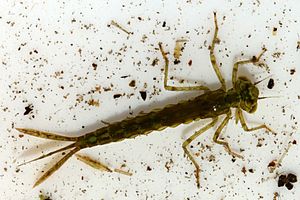
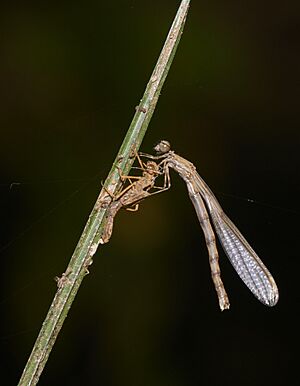
The nymphs are very hungry predators. They eat Daphnia (tiny water fleas), mosquito larvae, and other small water creatures. They breathe using three large, fin-like gills on their tail. These gills also help them move like a fish's tail.
The nymphs shed their skin about a dozen times as they grow. This is called molting. In the later stages, their wing pads start to show. When they are fully grown, the nymphs climb out of the water. They find a firm spot. Their skin on their chest splits open. The adult damselfly wiggles out.
At first, the adult's body is soft. It hangs or stands on its old nymph skin. It pumps a fluid called haemolymph into its small, floppy wings. The wings then get bigger. The haemolymph is then pumped back into its body. The body also gets bigger. The exoskeleton gets hard. The colors become brighter over the next few days.
Most damselflies come out during the day. If it is cool, the process takes several hours. On a hot day, the skin hardens fast. The adult can fly away in about half an hour.
Damselflies in Our World
Damselfly is the name of a short film from 2005. It was directed by Ben O'Connor. Damselfly is also a book from 2012. It is part of the Faeble series by S. L. Naeole. A poem from 1994 by August Kleinzahler is also called Damselfly. It has lines like "And that blue there, cobalt / a moment, then iridescent, / fragile as a lady's pin / hovering above the nasturtium?" The poet John Engels wrote Damselfly, Trout, Heron in his 1983 book of poems.
Fishing flies that look like damselfly nymphs are used in fishing. This is called wet-fly fishing. The hook and line sink below the water.
Damselflies have been used to inspire jewellery. Brooches that look like damselflies have been made since at least 1880.
Images for kids
-
Damselfly head showing compound eyes, ocelli, antennae, and mouth parts.
See also
 In Spanish: Zygoptera para niños
In Spanish: Zygoptera para niños


